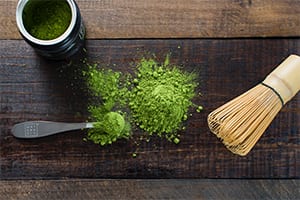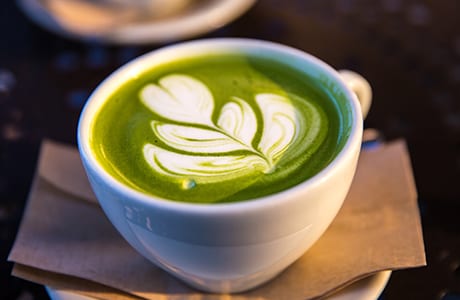In honor of St Patrick’s Day and a nod to all things green, we’re taking a look at the benefits of drinking the brilliant emerald-toned beverage‚ĶMatcha Green Tea!
Not only have researchers found that drinking tea lowers levels of the stress hormone, cortisol, but psychologists have proposed that the color green has many calming benefits. Add those two elements together for a soothing and comforting result we all could use a little more of this year.
Keep reading to learn more about the benefits of this ancient tea.
Matcha is a type of green tea that is generally viewed as the most beneficial. It is made up of catechins, a type of natural phenol. Phenols are a plant derived chemical that protects the plant from disease and works as a disinfectant and antioxidant. Matcha’s active ingredient is a polyphenol known as epigallocatechin 3-gallate (EGCG). EGCG has been shown to be as much as 100 times stronger in antioxidant activity than vitamins C and E. Studies have shown it also helps preserve cartilage and bone, but we should note that there are no controlled trials of it in people with arthritis. However, matcha combined with a healthy diet has long been shown to provide health benefits that include reducing inflammation.
History
The history of matcha can be traced all the way back to the Tang Dynasty in China that spanned the 7th – 10th centuries. During this time, the Tang Dynasty steamed tea leaves and formed them into bricks. This process made their tea harvests easier to transport and trade. The tea bricks were prepared by roasting and pulverizing the leaves then mixing the resulting tea powder with water and salt.
Even though the Tang Dynasty is largely credited with making this form of tea preparation popular, Eisai, a Japanese Buddhist Monk, brought the tea seeds back to Japan, along with the Zen Buddhist methods of preparing powdered green tea. This is the method that we now associate with matcha tea.
Preparing Matcha Tea
Matcha is made of finely ground powder from specially grown and processed green tea leaves. What makes it unique from traditional green tea is two aspects of farming and processing: the green tea plants used for matcha are shade-grown for three to four weeks before harvest, and the stems and veins are removed during processing. The powdered form of matcha is consumed differently than from tea leaves or tea bags, as it is suspended in a liquid, typically water or milk.
Using a bamboo whisk and a tea bowl, here are the steps for preparation:
- Sift 1-2 tsp matcha into a cup using a small sifter.
- Add 2 oz hot water. For best results use water just under a boil.
- Whisk vigorously in a zig zag motion until the tea is frothy.
- Enjoy your matcha tea straight from the bowl.
Preparing and drinking matcha tea is not only a way to incorporate a healthy habit into your routine, but a great opportunity to slow things down and be mindful and present.
Sip, Relax, and Enjoy!
[toggle title_open=”Sources” title_closed=”Sources” hide=”yes” border=”no” style=”default” excerpt_length=”0″ read_more_text=”Read More” read_less_text=”Read Less” include_excerpt_html=”no”]
https://www.healthline.com/nutrition/7-benefits-of-matcha-teahttps://arthritis.org/health-wellness/healthy-living/nutrition/healthy-eating/best-drinks-for-arthritishttps://www.matchaful.com/pages/the-history-of-matcha
[/toggle]




